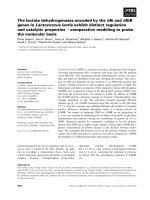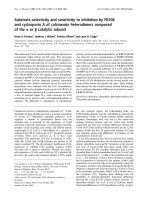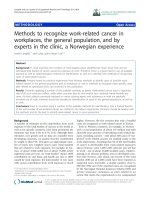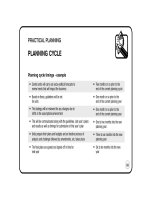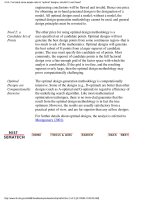Alteration in the sensitivity to crizotinib by Na+ /H+ exchanger regulatory factor 1 is dependent to its subcellular localization in ALK-positive lung cancers
Bạn đang xem bản rút gọn của tài liệu. Xem và tải ngay bản đầy đủ của tài liệu tại đây (5.2 MB, 12 trang )
Yang et al. BMC Cancer
(2020) 20:202
/>
RESEARCH ARTICLE
Open Access
Alteration in the sensitivity to crizotinib by
Na+/H+ exchanger regulatory factor 1 is
dependent to its subcellular localization in
ALK-positive lung cancers
Fenglian Yang1,2†, Mu Hu2,3†, Siyuan Chang1,2, Jing Huang1,2, Yang Si1,2, Jinghui Wang4, Shan Cheng1,2*
Wen G. Jiang1,2,5
and
Abstract
Background: Na+/H+ exchanger regulatory factor 1 (NHERF1) is an important scaffold protein participates in the
modulation of a variety of intracellular signal pathways. NHERF1 was able to enhance the effects of chemo-drugs in
breast and cervical cancer cells. Anaplastic lymphoma kinase (ALK) fusion mutations are validated molecules
targeted therapy in lung cancers, where crizotinib can be used as the specific inhibitor to suppress tumor
progression. However, due to the less frequent occurrence of ALK mutations and the complexity for factors to
determine drug responses, the genes that could alter crizotinib sensitivity are unclear.
Methods: Both ALK-translocated and ALK-negative lung adenocarcinoma specimens in tissue sections were
collected for immunohistochemistry. The possible mechanisms of NHERF1 and its role in the cell sensitivity to
crizotinib were investigated using an ALK-positive and crizotinib-sensitive lung adenocarcinoma cell line H3122.
Either a NHERF1 overexpression vector or agents for NHERF1 knockdown was used for crizotinib sensitivity
measures, in association with cell viability and apoptosis assays.
Results: The expression level of NHERF1 in ALK-translocated NSCLC was significantly higher than that in other lung
cancer tissues. NHERF1 expression in ALK positive lung cancer cells was regulated by ALK activities, and was in
return able to alter the sensitivity to crizotinib. The function of NHERF1 to influence crizotinib sensitivity was
depending on its subcellular distribution in cytosol instead of its nucleus localized form.
Conclusion: Ectopically overexpressed NHERF1 could be a functional protein for consideration to suppress lung
cancers. The determination of NHERF1 levels in ALK positive NSCLC tissues might be useful to predict crizotinib
resistance, especially by distinguishing cytosolic or nuclear localized NHERF1 for the overexpressed molecules.
Keywords: NHERF1, Crizotinib, ALK, Lung cancer, PDZ protein
* Correspondence:
†
Fenglian Yang and Mu Hu contributed equally to this work.
1
School of Basic Medical Sciences, Capital Medical University, Beijing 100069,
People’s Republic of China
2
Beijing Key Laboratory of Cancer & Metastasis Research, Capital Medical
University, Beijing, China
Full list of author information is available at the end of the article
© The Author(s). 2020 Open Access This article is licensed under a Creative Commons Attribution 4.0 International License,
which permits use, sharing, adaptation, distribution and reproduction in any medium or format, as long as you give
appropriate credit to the original author(s) and the source, provide a link to the Creative Commons licence, and indicate if
changes were made. The images or other third party material in this article are included in the article's Creative Commons
licence, unless indicated otherwise in a credit line to the material. If material is not included in the article's Creative Commons
licence and your intended use is not permitted by statutory regulation or exceeds the permitted use, you will need to obtain
permission directly from the copyright holder. To view a copy of this licence, visit />The Creative Commons Public Domain Dedication waiver ( applies to the
data made available in this article, unless otherwise stated in a credit line to the data.
Yang et al. BMC Cancer
(2020) 20:202
Background
Na+/H+ exchanger regulatory factor1 (NHERF1) is an
important molecule among the four protein family
(NHERF1, NHERF2, NHERF3, NHERF4). NHERF1 is
generally regarded as a multifunction cellular scaffold
protein containing two structural domains of PDZ1 and
PDZ2 upstream of an ezrin–radixin–moesin-binding
element. NHERF1 is known to interact with a variety of
proteins of great importance in human cancers, including platelet-derived growth factor receptor (PDGFR) and
phosphatase and tensin homolog (PTEN) [1]. By counterbalancing PI3K/Akt oncogenic signals, NHERF1 enhanced cell responses to PDGFR inhibitor [1]. Mutations
at NHERF N-terminus within the conserved PDZ domains hampered its interaction with SYK, promoted the
progression of breast cancer [2]. NHERF1 binding to the
C-terminal of EGFR inhibited its phosphorylation and
attenuated downstream signaling [3].
The differential and heterogeneous expression of
NHERF1 is related to the progression of several tissues.
In polarized colorectal epithelia, NHERF1 distributed at
the apical luminal, but disrupted in cancer cases [4]. In
transformed cells, cytoplasmic ectopic NHERF1 expression increased cell proliferation and accelerated the development of malignant phenotype [5]. During the early
stages of carcinogenesis in colorectal cancers, nuclear
NHERF1 was correlated with poor prognosis [4]. In
HCC models, NHERF1 and β-catenin colocalized in the
nucleus and functioned as a positive regulator of Wnt
signaling and contributed to the malignant phenotype
[6]. In breast cancer, increased cytoplasmic NHERF1
and decreased membranous localization during ductal
carcinoma in situ (DCIS) transformed into invasive and
metastatic types [7]. These data implied that NHERF1
could contribute to the progression of cancers based on
its expression and cellular distribution.
Lung cancers are the leading types of cancers over the
world in both incidence and morbidity, approximately
85% of which are non-small cell lung cancers (NSCLC)
[8]. The five-year survival was merely about 15% following optimized chemotherapy procedures [9]. The recent
development using targeted therapy has greatly encouraged the screening of novel lung cancer markers for effective drugs or treatment assessments. The anaplastic
lymphoma kinase gene (ALK) is a new driving gene of
NSCLC following the discovery of EGFR mutations.
ALK is a 1620 amino acid transmembrane protein consisting of extracellular ligand binding, transmembrane
and intracellular tyrosine kinase domains [10]. In 2011,
the US FDA has approved crizotinib to be used for the
treatment of ALK-translocated locally advanced or metastatic NSCLC patients [11]. The diagnosis of ALKtranslocated lung cancer took place in 3–5% in all
NSCLC patients [12]. Although resistance of crizotinib
Page 2 of 12
was reported in ALK positive patients subjected to the
procedures of targeted therapy, the possible mechanism
was poorly understood to date [13]. Comparing to other
drugs, genes that influenced the sensitivity of crizotinib
were less reported due to the low frequency of ALK mutations in patients.
From previous studies in NSCLC, NHERF1 proteins in
the plasma were increased in patients, suggesting
NHERF1 might be useful for the evaluating tumor development and progression. A recent study involving 26
cases of NSCLC tumor puncture and 18 cases of
matched tissue sections showed that the increase and
mislocation of NHERF1 from immunohistochemistry
could be used to indicate cancer invasion [14]. It was
also reported that NHERF1 elicited pharmacologic effect
to enhance drug response of geftinib and imatinib in
breast cancers [15]. In cervical cancer cells, NHERF1, as
a putative interaction partner, reduced the stability of
MRP4 by facilitating its internalization from cell surface
to sensitize cisplatin-refractory [16]. These findings
prompted us to evaluate the role of NHERF1 in ALK
positive NSCLC in connection with the sensitivity to crizotinib treatments.
In the present study, both ALK-translocated and
ALK-negative lung adenocarcinoma specimens in tissue
sections were collected for immunohistochemistry. An
ALK-positive and crizotinib-sensitive lung adenocarcinoma cell line H3122 was used as the laboratory model
for experiments. Either a NHERF1 overexpression vector or agents for NHERF1 knockdown was used for crizotinib sensitivity measures, in association with cell
viability and apoptosis assays. The results showed that
NHERF1 ectopic expression was able to increase the
drug sensitivity of crizotinib treatments. Our findings
also suggested ALK activity and downstream signals
were not only involved to regulated NHERF1 expression, but also affected the subcellular localization.
NHERF1 could be a useful referencing marker to evaluate drug resistance, at least the sensitivity of crizotinib
in NSCLC cells.
Methods
Tissue sample collection and database accession
Lung adenocarcinoma tissues were collected with the
approval by the ethics committee from Beijing Xuanwu
Hospital. A total of 10 ALK-positive patients were included with the confirmed diagnosis from the pathology
department. ALK rearrangements were identified on
formalin-fixed, paraffin-embedded (FFPE) tumors using
Vysis ALK Break Apart FISH Probe Kit (Abbott Molecular, Abbott Park, IL, USA). Additional 10 ALK-negative
lung adenocarcinoma tissues matched for similar clinical
stage and grade were randomly selected for comparative
studies. All tumor specimens were prepared at the time
Yang et al. BMC Cancer
(2020) 20:202
of surgical resection, and then fixed in 10% neutral buffered formalin for 24 h following an identical SOP. The
processed samples were subjected to IHC analyses. For
cross-reference, the NHERF1 gene expression data for
normal lung or cancerous adenocarcinoma tissues were
extracted from GEO dataset (GSE31210), and then used
for statistical analyses.
Chemical reagents and plasmids
Crizotinib was purchased from HARVEY (Beijing,
China). The siRNA targeting sequences for NHERF1
was designed as 5′-GCUAU GGCUU CAACC UGCAT
T-3′ and 5′-GAAGG AGAAC AGUCG UGAAT T-3′.
The synthetic interfering RNA in duplex was transfected
into cells seeded in 6-well plates. A scrambled siRNA
5′-UUCUU CGAAC GUGUC ACGUT T-3′ (GenePharma, Suzhou, China) was used in control samples.
Heparin was purchased from Bellancom (Beijing, China).
The NHERF1 overexpression plasmid fused with a 3 ×
FLAG tag was prepared as previously described [17].
Cell culture and transfection
H3122, the human adenocarcinoma ALK-positive
NSCLC cell line, harbouring EML4-ALK variant 1 fusion
gene was purchased from Kebai Biotechnology Co. Ltd.
(Nanjing, China) and maintained in RPMI 1640 (Gibco,
Carlsbad, CA, USA) supplemented with 10% fetal bovine
serum (FBS) (ExCellBio, Shanghai, China) and 1% P/S
antibiotics (Gibco BRC, Paisley, Scotland, UK). The
transfection of plasmids or siRNAs were carried out
using the Neofect™ DNA transfection reagent (Neofect
Biotech, Beijing, China) or Lipofectamine® 2000 transfection reagent (Invitrogen, Paisley, Scotland, UK). The
total proteins were extracted at 48 h post-transfection.
The protein levels in treated cells following NHERF1
gene overexpression or its siRNA inhibition were determined by western blotting.
Page 3 of 12
supernatant was used as the nuclear fraction. The prepared samples were stored at − 80 °C for subsequent
analyses.
Western blotting
The treated cells were lysed following a standard protocol. The protein expression was assessed through sodium dodecyl sulfate-polyacrylamide gel electrophoresis
(SDS-PAGE) and western blotting analysis. For ALK signaling experiments, confluent cell monolayer of the
H3122 cells were serum-free starved 24 h and then exposed to 100 μg/ml heparin for 30 min. The antiNHERF1 antibody was purchased from BD Transduction
Laboratories (BD Biosciences, San Diego, CA, USA). The
anti-GAPDH, anti-ERK, anti-p-ERK and anti-Coilin
antibodies were purchased from Santa Cruz Biotechnology (Santa Cruz, CA, USA). The anti-AKT, anti-p-AKT
(Ser473), anti-ALK, anti-p-ALK (Tyr1604) antibodies
were from Cell Signaling Technology (Danvers, MA,
USA). The β-action antibody was obtained from ABclonal Biotechnology (Wuhan, Hubei, China). The protein
expression levels were semi-quantified by densitometry
of the western blot bands using the ImageJ2 software.
Cell proliferation assay
For each well, a number of 3000 cells were seeded in
96-well plates and continuously cultured for 0, 1, 2, 3
and 4 days. The cell growth was assayed by adding
100 μl of cell counting kit (CCK8) (Dojindo,
Kamimashiki-gun, Kumamoto, Japan) solution at 1:10
dilution in culture medium for staining at 37 °C for 1 h.
The plates were scanned at absorbance wavelength of
450 nm using a spectrophotometer (BioTek, Winooski,
VT, USA) for detection. Each data point was measured
in six duplicates. The experiments were repeated for 3
times independently.
Apoptosis assay
Cytoplasmic and nuclear extracts
Cells were seeded in 10-cm plates with or without
treatments for 48 h, and then harvested in 1000 μl of
cold phosphate-buffered saline (PBS). Collected cells
were centrifuged (4 °C) at 500 g for 2 min, washed
twice with cold PBS, and resuspended in 400 μl of cold
lysis buffer (10 mM HEPES, 50 mM NaCl, 5 mM
EDTA, 1 mM Benzamidine, 0.5% Triton X-100). The
lysates were vortexed for 15 s and placed on ice for
20 min. The samples were centrifuged for 1 min (2000
g) at 4 °C and the supernatant were collected as the
cytoplasmic fraction. The precipitate was resuspended
in 40 μl nuclear lysis buffer. The cytoplasmic or nuclear lysate were placed on ice for 40 min and vortex
for 10 min at 15 s with intervals. The final homogenate
was centrifuged at 16,000 g for 10 min (4 °C) and the
Cells were seeded in 6-well plates at the density of 1 ×
105 cells/well. The treatments with crizotinib at 10 μM
were maintained for 24 h. In the control group, the cells
were treated vehicle (DMSO) only for dissolving the
drugs. The cell apoptosis was assessed using a MUSE™
Annexin V Dead Cell Kit (EMD Millipore Corporation,
Hayward, CA, USA) following the manufacturer’s
protocol.
Immunofluorescence
Cells were plated at a density of 1.0 × 105 per well into
6-well plates pre-placed with a glass coverslip. Following
transfection, the cells on coverslips were treated with/
without heparin and then washed three times with cold
PBS. After fixed with 4% paraformaldehyde at room
temperature for 30 min, the cells were permeabilized
Yang et al. BMC Cancer
(2020) 20:202
and blocked with a buffer containing 0.3% Triton X-100
and 5% bovine serum albumin for 30 min. To determine
the subcellular localization of NHERF1, cells were
probed with monoclonal mouse anti-human NHERF1
primary antibody (1:100) (BD Transduction Laboratories) and anti-Flag primary antibody (1:200) (Sigma-Aldrich, St. Louis, MO, USA). Following extensive wash
for removing the primary antibodies, the cells were incubated with an Alexa Fluor® 488 donkey anti-mouse IgG
(Life Technologies, MA, USA) at 1:200 dilution in the
dark for 1 h. Prior to the examination under a fluorescent microscope, cell nuclei were stained with Hoechst
33258 (Sigma-Aldrich). Images were acquired with a
confocal system (Leica Microsystems LAS AF-TCS SP5.
Wetzlar, Germany). Control samples without adding primary or secondary antibodies were prepared for evaluating the non-specific staining in this study.
Page 4 of 12
Immunohistochemistry (IHC)
The 5 μm sections of collected lung tissues were deparaffinized, rehydrated, rinsed with distilled water, and
washed with Tris-buffered saline (TBS). Automated IHC
staining was carried out using a Ventana BenchMark
GX instrument (Ventana Medical Systems, Inc., Tucson,
AZ, USA). NHERF1 was probed with an anti-NHERF1
antibody (1:100, Abcam, Cambridge, MA, USA). Image
Pro Plus 6.0 (Media Cybernetics, Inc., Rockville, MD,
USA) was used to calculate the intensity of NHERF1
staining. Randomly selected 10 microscopic fields were
imaged for each sample subjected to computer-assisted
imaging analyses. The results were presented as the
mean ± standard deviation (SD). The determination of
immunohistochemical staining intensity and positive
areas for NHERF1 in IOD (integral optical density) measures were performed by two independent staffs who
Fig. 1 Upregulated levels of NHERF1 expression were observed in ALK positive lung adenocarcinoma tissues. a Detection of NHERF1 protein by
immunohistochemistry in tissue sections from ALK-translocated lung adenocarcinoma patients and compared to matched controls. b
Quantification of (a) when n = 10 in both groups. c Relative NHERF1 mRNA levels in lung adenocarcinoma tissues (n = 226) from Set GSE31210 in
the GEO database and the normal lung tissues (n = 20). d Stratified NHERF1 mRNA levels in ALK-translocated lung adenocarcinoma tissues (n =
11) and ALK negative samples (n = 215). *p < 0.05, **p < 0.01;***p < 0.001
Yang et al. BMC Cancer
were mutually
information.
(2020) 20:202
blinded
to
the
Page 5 of 12
sample
grouping
Statistical analyses
The quantitative data were presented as mean ± SD and
subjected to Student t-test. Statistical significance was
called at p < 0.05. The charts were generated by Prism
V5.0 (GraphPad Software, Inc., La Jolla, CA, USA).
Results
NHERF1 expression was increased in ALK positive lung
adenocarcinoma tissues
Using the ALK-positive and ALK-negative lung adenocarcinoma specimens collected from Beijing Xuanwu
Hospital, we analysed the expression of NHERF1 by immunohistochemistry on tissue sections. We found that
the NHERF1 staining was much more intensive in
samples of ALK-translocated tissues, compared to that
in ALK-negative lung adenocarcinoma tissues (Fig. 1a).
The subsequent statistics with the IHC semiquantification indicated that the difference was significant (p < 0.05) (Fig. 1b). We also evaluated the NHERF1
mRNA expression using the data extracted from GEO
dataset (GSE31210), where the mRNA expression pattern in 246 tissue specimens was documented. Relative
NHERF1 mRNA in lung adenocarcinoma was over the
normal tissues (p < 0.01) (Fig. 1c). Increased level of
NHERF1 was again found to be more significant for
ALK-translocated tissues and compared to those in the
tissues of ALK negative samples (p < 0.001) (Fig. 1d).
Not only we supplied additional data of the NHERF1 expression at the protein levels, we argue that besides the
high relative NHERF1 mRNA in lung adenocarcinoma
over the normal tissues, whether the elevated level of
NHERF1 is associated with the abnormal activation of
ALK or related signaling needs to be investigated.
The upregulation of NHERF1 expression was dependent
to the activation of ALK signaling
To address whether NHERF1 expression could be a consequence upon the activation of ALK signaling, we
conducted laboratory experiment in H3122 cells, which
is known as a commonly used ALK-positive and
crizotinib-sensitive lung adenocarcinoma cell line. As
crizotinib is the specific inhibitor of ALK, with which
the treatment in H3122 cells significantly reduced the
level of NHERF1 for its expression (Fig. 2a). Heparin is a
potent activating ligand of ALK for its receptor tyrosine
kinase activity. When cells treated with heparin, robust
autophosphorylation of ALK can be observed. In heparin
treated H3122 cells, the endogenous expression of
NHERF1 was significantly increased and was in a dose
dependent fashion (Fig. 2b). These data suggested the elevated NHERF1 expression levels could very well be a
Fig. 2 Effect of ALK signaling on NHERF1 expression (a) The
expression of NHERF1 during the time course of crizotinib treatment
for 7 days in H3122 cells (Full-length blots/gels are presented in
Suppl Figure 2). b A dose dependent autophosphorylation of ALK
through heparin stimulation increased NHERF1 expression in H3122
cells. (Full-length blots/gels are presented in Suppl Figure 2)
subsequent response following the activation of ALK
and downstream signaling in ALK-translocated lung
adenocarcinomas.
Knockdown of NHERF1 expression attenuated the
sensitivity of H3122 cells to crizotinib
From previous reports in breast cancer and cervical cancer cells, NHERF1 was shown to be able to influence the
sensitivity of a variety of anti-cancer drugs [18, 19]. We
started to wonder if such pharmacologic functions of
NHERF1 can also be observed in lung cancers, especially
in ALK positive lung cancer cells. We used the transfection of interfering siRNAs and prepared NHERF1 knockdown models in H3122 background. The expression
level of NHERF1 was considerably decreased in transfected cells as shown by western blotting, compared with
scramble control cells (Fig. 3c). The sensitivity to crizotinib were assayed through the measures in the cell viability and rate of apoptosis in transfected H3122 cells.
The cell apoptosis was observed to be significantly inhibited following 10 μM crizotinib treatments, as shown in
Fig. 3a,b by flow cytometry (from 35 to 22% or 19%). By
knockdown of NHERF1 expression in H3122 cells, Increased cell survival was observed from the crizotinib
dose administration curve (Fig. 3d). These results indicated that the knockdown of NHERF1 could reduce the
sensitivity to crizotinib in ALK-positive cells.
Yang et al. BMC Cancer
(2020) 20:202
Page 6 of 12
Fig. 3 Effects of NHERF1 knockdown on the sensitivity of H3122 cells to crizotinib. a Rate of cell apoptosis by flow cytometry with 10 μM
crizotinib treatments. b Quantification and statistics from (a) and repeated experiments (n = 3). c The knockdown of NHERF1 at protein levels as
determined by western blotting (Full-length blots/gels are presented in Suppl Figure 3). d The cell survival from MTS assays in H3122 and
NHERF1 knockdown cells in the presence of crizotinib (0, 2, 5, 10, 20 and 50 μM). **p < 0.01, ***p < 0.001
Knockdown of NHERF1 promoted cell growth and
enhanced ALK activation
To further examine whether NHERF1 knockdown in
ALK positive cells indeed alters the ALK kinase activity
thus to alter crizotinib sensitivity, we analyzed the phosphorylation of ALK and related signal molecules. In
NHERF1 knockdown H3122 cells, the levels of phosphorylated ALK were significantly increased (Fig. 4a) following 15 min stimulation with 20% FBS, which is a
known treatment for activating ALK. In addition, the
phosphorylation of AKT and ERK were also increased
(Fig. 4c). As both ERK and AKT were possible
downstream proteins of ALK to regulate cell growth and
proliferation, we evaluated the effect of NHERF1 knockdown on growth. As shown in Fig. 4b, the increase in
CCK8 assays of 125 and 150% was observed following
the transfection of two pairs of siRNAs, respectively.
These data suggested that reduction in NHERF1 expression led to the increased of cell growth in H3122 cells,
which involved the increased phosphorylation of ALK
and subsequent enhancement in downstream signal activation of AKT and ERK. This at least partially explained
previously discovered crizotinib sensitivity loss after
RNAi of NHERF1, where the accompanied increase in
Yang et al. BMC Cancer
(2020) 20:202
Page 7 of 12
Fig. 4 Effects of NHERF1 Knockdown on cell viability and related
signals. a Knockdown expression of NHERF1 significantly promoted
FBS-induced ALK activation in H3122 cells (Full-length blots/gels are
presented in Suppl Figure 4). b MTS assays for cell growth in H3122
and NHERF1 knockdown cells (n = 6). c Knockdown expression of
NHERF1 on the expression and phosphorylation of AKT and ERK.
(Full-length blots/gels are presented in Suppl Figure 4)
ALK activation is expected to require increased drug
dose to achieve the same level of induction for
apoptosis.
Overexpression of NHERF1 inhibited the activation of ALK
signal and suppressed cell growth
We next explored on whether NHERF1 overexpression
in H3122 cells will give a reversed phenotype comparing
to the knockdown situation. A plasmid carrying an
expression cassette of NHERF1 was transfected into
H3122 cells, and the protein levels were assessed by
western blotting (Fig. 5b). A mild reduction of cell
growth to 80% was observed in NHERF1 transfected
cells comparing to the vector control (Fig. 5a). However,
the suppression on FBS-induced ALK phosphorylation
Fig. 5 Effects of NHERF1 overexpression on cell viability and related
signals. a MTS assays for cell growth in H3122 and NHERF1
overexpressed cells (n = 6). b Over-expression of NHERF1 significantly
inhibited FBS-induced ALK, AKT and ERK activation (Full-length blots/
gels are presented in Suppl Figure 5)
and associated AKT and ERK activation appeared to be
more substantial under NHERF1 overexpression (Fig.
5b). The results suggested that NHERF1 overexpression
decreased activation of ALK and associated ERK or AKT
signaling. It is also implied that the resulted inhibition
Yang et al. BMC Cancer
(2020) 20:202
on apoptosis seemed to be more significant than that on
cell growth.
NHERF1 overexpression sensitized H3122 cells to
crizotinib treatments
Indeed from the crizotinib sensitivity assays, the apoptosis of H3122 cells increased to 12% in NHERF1 overexpressed cells from a basal level of 7% in the vector
controls. When cells exposed to 10 μM crizotinib for 24
h, a 35% apoptosis rate increased to 47% with ectopic
overexpression of NHERF1 in H3122 cells (Fig. 6a,b).
Besides, overexpression of NHERF1 significantly reduced
the cell survival in the presence of crizotinib as compared to the empty vector-transfected control cells (Fig.
Page 8 of 12
6c). These results verified our findings from previous experiments demonstrated the importance of NHERF1 in
ALK-translocated lung adenocarcinoma cancer cells.
Ectopically expressed NHERF1 differed from the
endogenous proteins in subcellular localization in cancer
cells and exerted more potent inhibition on cell growth
and drug sensitivity
Although NHERF1 is generally consensed as a gene with
tumor suppressor functions, it is not quite understood
why it often upregulated in malignant cancer cells. Recent studies showed that the cellular distribution of
NHERF1 was significantly different in cancers from
normal tissues of same origins, where NHERF1 protein
Fig. 6 Effects of NHERF1 overexpression on the sensitivity of H3122 cells to crizotinib. a Rate of cell apoptosis by flow cytometry with 10 μM
crizotinib treatments. b Quantification and statistics from (a) and repeated experiments (n = 3). c The cell survival from MTS assays in H3122 and
NHERF1 overexpressed cells in the presence of crizotinib (0, 2, 5, 10, 20 and 50 μM). *p < 0.05
Yang et al. BMC Cancer
(2020) 20:202
might shifted from the plasma membrane to the cytoplasm or nucleus [20]. In our experiments, immunofluorescence was used to examine the subcellular
localization of NHERF1 in H3122 cells. From the representative images, endogenous NHERF1 could be identified at membrane structures, as well as in the cytoplasm
or nuclei (Fig. 7a Upper). When incubated cells in
100 μg/ml heparin, the increased expression of NHERF1
proteins was significant as predominantly found in the
nuclei of H3122 cells (Fig. 7a Lower). Nevertheless, the
ectopic overexpression of NHERF1 through plasmid
transfection resulted in the protein to be distributed
with its natural existence in the membrane or cytoplasm
(Fig. 7c, d). From the western blot individually probing
NHERF1 in the cytoplasmic and nuclear forms, the
found pattern could be confirmed (Fig. 7b, c). We postulated that the ALK activation induced NHERF1 tended
Page 9 of 12
to be selectively transported into the nuclei, and such
mislocalized NHERF1 proteins were likely abolished the
normal functions to suppress the growth and survival of
cancer cells.
Discussion
The upregulation of NHERF1, as a suggestive poor prognosis indication, was earlier discovered in breast cancers
for its association with tumor malignancy and metastatic
progression [21]. Latest studies attempted to discriminate the diverged functions of NHERF1 with different
subcellular distribution. Cytoplasmic NHERF1 was detected higher in primary cancer than in adjacent normal
mucosa, and implicated nodal and distant metastases or
lymphovascular invasion (LVI) [7]. Nuclear NHERF1
was identified in colorectal cancer of early stages and
was believed to participate the onset of the malignant
Fig. 7 Subcellular localization of endogenous, ALK-induced or ectopic overexpressed NHERF1 proteins in H3122 cells. a Immunofluorescent
microscopy in native H3122 cells (upper) or cells treated with Heparin (100 μg/ml) for 30 min (lower). b Western blot analyses for cytoplasm or
nuclear distribution of NHERF1 proteins, where Coilin was used as a nuclear maker (Full-length blots/gels are presented in Suppl Figure 6). c
Western blot of NHERF1 in cells transfected with a Flag-NHERF1 plasmid for ectopic overexpression (Full-length blots/gels are presented in Suppl
Figure 6). d Confocal microscopy for distinguishing ectopic NHERF1 vs. the endogenous protein
Yang et al. BMC Cancer
(2020) 20:202
phenotype during carcinogenesis leading to poor prognosis [22]. In lung cancers, NHERF1 protein was increased in both plasma and tissues from NSCLC
patients. NHERF1 interaction partners can be either
cytoplasmic or nuclear factors, regulated by a wide range
of signals in breast cancer or colorectal cancers, such as
VEGFR and HIF-1ɑ, some of which closely associated
with lymphatic metastasis [17, 23]. Besides HIF-1ɑ, NFκB was another important nuclear transcription factor
demonstrated to interact with NHERF1 dependent to
the activation of Ras/MEK/ERK or PI3K/Akt signaling
[24]. In primary macrophages and vascular smooth
muscle cells, NF-κB in return was shown to promote the
expression of NHERF1. From this study, a high level of
NHERF1 expression was found in lung cancer tissues,
especially in patients diagnosed with ALK-translocation
(Fig. 1). ALK was a known activator of AKT and ERK
signaling pathways upstream of NF-κB or HIF-1ɑ mediated transcription of the regulated genes, therefore it
was worthwhile to exploit whether the activation of ALK
signal was sufficient or responsible to modulate NHERF1
expression. As predicted, we found that ALK activation
induced by heparin in coordination with ERK and AKT
phosphorylation upregulated the transcription and expression of NHERF1 (Fig. 2b). The result immediately
suggested that NHERF1 might influence the sensitivity
to crizotinib in ALK targeted therapies, as implied from
Fig. 2a.
NHERF-interacting proteins, comprising transporters,
membrane receptors, junction proteins or signaling molecules, have been identified with a function to influence
the cell survival following treatments of chemo-drugs
[19]. It is no surprise for NHERF1 to alter the sensitivity
or resistance to cancer drugs. In fact, NHERF1 has also
been suggested to connect with tumor sensitivity to
drugs targeting EGFR, MRP4 or MRP2 [18]. The knockdown of NHERF1 expression reduced crizotinib sensitivity in ALK-positive H3122 cells via its inhibition on cell
apoptosis (Fig. 3a,d) and promotion of cell growth (Fig.
4a). Further results from NHERF1-overexpressed H3122
cells (Figs. 5 and 6) were able to verify the role of
NHERF1 on crizotinib sensitivity, except for the effects
on cell growth was weak. These results were consistent
with the ectopic overexpression of NHERF1 significantly
reduced the heparin-induced cell growth in H3122 cells
(suppl fig. 1). NHERF1 is a scaffold protein, which can
form complex network through its two PDZ domains to
regulate many cellular signal pathways [16]. A majority
of the molecular interactions involving the binding of
NHERF1 is dependent to protein phosphorylation [1].
The dentification for major NHERF1 interaction protein
with its chemical modification status will be particularly
helpful to understand the exact mechanism explaining
the effect of NHERF protein on drug sensitivities. To the
Page 10 of 12
best of our knowledge, there is no evidence indicating a
direct interaction between NHERF and ALK, the connection of NHERF1 to ALK activation was not previously reported and needed to be further studied.
NHERF1 was suggested to play an essential role in
cancer initiation, development, progression and metastasis [6]. An important finding from this study was the differential effect of NHERF1 functions linked to its
localization. Ectopic expression of NHERF1 preferred a
cytoplasm distribution and led to strong inhibition of
cell growth (Figs. 5 and 7). Thus, it remained to be considered as a potential candidate for manipulation to treat
cancers as previously recognized. The nuclear NHERF1
played a role on promoting tumor progression through
the interaction with YAP and increased YAP translocation into the nucleus for transcription activation [25]. In
a few reports, it was also implied that NHERF1 lost its
tumor suppressive function once mislocated from the
cytoplasm into the nucleus, or even worse acted as a
pro-oncogene product. We found that the translocation
of NHERF1 happened to heparin-induced endogenous
NHERF1 expression in ALK positive cancer cells (Fig.
7). The results partially explained why malignant cancer
cells not only sustained high NHERF1 expression but
also might benefit from the outcome for proliferation
preference. Continuous explore about the complex
mechanisms of NHERF1 regulating functions in cancers
will supply more evidence to address the remaining
questions.
Crizotinib is a first-generation ALK-TKI applied to
NSCLC subtypes. Resistance to crizotinib can occur via
secondary mutations or amplification in the ALK gene.
Cancer cells may adopt various strategies, such as amplified KIT signaling, increased EGFR phosphorylation,
KRAS mutations oncogene, or increased NRG1 for activating HER2/3 kinases to survive crizotinib treatments
[26]. Epithelial-mesenchymal transition (EMT) was suggested to be a critical process to confer resistance to
crizotinib in NSCLC. NHERF1 suppressed EGFR phosphorylation and inhibited EGF-induced proliferation/migration in breast cancer cells [27]. Previous studies
showed that NHERF1 suppressed lung cancer cell migration by attenuating EMT process. Loss of the interaction
between NHERF1 and EGFR induced EMT phenotypic
features in biliary cancer cells [28]. We found crizotinib
reduced the expression of NHERF1 (Fig. 2a), implying
that the inhibition of NHERF1 on EGFR phosphorylation was compromised. NHERF1 was discovered as putative interaction partners of MRP4 [16] in cervical
cancers [19]. It implied that monitoring changes in
NHERF1 levels could be used to predict loss of crizotinib sensitivity during drug treatments, as the inhibitory
function of NHERF1 to EMT contributed to crizotinib
drug resistance.
Yang et al. BMC Cancer
(2020) 20:202
The role of NHERF1 in drug resistance in lung cancers
deserves more investigation for clues to understand the
underlining mechanism. By characterization the effects
of NHERF1 with its regulation on tumor cell responses
to crizotinib, we have demonstrated a dynamic interplay
between NHERF1 and ALK signaling in lung adenocarcinoma cells. Upregulation of NHERF1 in lung
adenocarcinoma needs to be scrutinized during the administration of ALK-targeting drugs. The reduction in
NHERF1 expression in cancer cells treated with crizotinib is likely to suggest acceleration of tumor progression, as well as the resistance to drugs. The expression
and subcellular distribution of NHERF1 might be a potential prognostic factor to predict the benefit in patients
subjected to ALK targeted therapies.
Conclusion
The present study not only reemphasized NHERF1 as a
potential marker to evaluate the malignancy and progression in ALK-translocated non-small cell lung cancers, similar to what has been reported in other cancer
types, but also further demonstrated the increased
NHERF1 expression was regulated by ALK activation.
The sensitivity to ALK-targeted drug crizotinib was related ERK or AKT signals to influence cell growth and
apoptosis. The ALK-induced NHERF1 expression appeared to have distinct cellular localization from ectopic
overexpressed forms, which contributed differently to
cell survival, growth and drug sensitivity. Our findings
provided a new perspective for understanding the underlying mechanisms for ALK-translocated lung adenocarcinoma to survive from crizotinib treatments.
Supplementary information
Supplementary information accompanies this paper at />1186/s12885-020-6687-9.
Additional file 1.
Additional file 2.
Abbreviations
ALK: Anaplastic lymphoma kinase; CCK8: Cell counting kit; DCIS: Ductal
carcinoma in situ; EMT: Epithelial-mesenchymal transition; FBS: Fetal bovine
serum; FFPE: Formalin-fixed, paraffin-embedded; IHC: Immunohistochemistry;
IOD: Integral optical density; LVI: Lymphovascular invasion; NHERF1: Na+/H+
exchanger regulatory factor 1; NSCLC: Non-small cell lung cancers;
PBS: Phosphate-buffered saline; PDGFR: Platelet-derived growth factor
receptor; PTEN: Phosphatase and tensin homolog; SD: Standard deviation;
SDS-PAGE: Sodium dodecyl sulfate-polyacrylamide gel electrophoresis;
TBS: Tris-buffered saline
Acknowledgements
We thank to professor Wei Ding from Department of Medical Genetics and
Developmental Biology for his contribution during the drafting and revision
of this manuscript.
Authors’ contributions
Experiment design and project supervision: S.C. Conduction of experiments:
F.Y., M.H., S-Y.C., J. H, Y.S. (tissue culture, sample preparation, molecular assays,
Page 11 of 12
morphological examination, etc.). Patients and specimen management, collection of clinical information: M.H., J.W. and W-G. J. Data analyses, manuscript drafting and revision: F. Y., M.H. and S.C. All authors read and approved
the final manuscript.
Funding
This work was funded by the Supporting Project for High Caliber Teachers in
Beijing Municipal Universities during the “13th Five-year Plan”
(IDHT20170516). The funding source has no role in study design, data collection, analysis, interpretation, the writing of the manuscript, or the decision to
submit the current study.
Availability of data and materials
Public online or upon request.
Ethics approval and consent to participate
The study ethics approval was granted from the local ethical committee of
the Beijing Xuanwu Hospital, and the study was performed in accordance
with the principles of the Declaration of Helsinki. Written informed consent
was obtained from all patients.
Consent for publication
Not applicable.
Competing interests
The authors declare that they have no competing interests.
Author details
1
School of Basic Medical Sciences, Capital Medical University, Beijing 100069,
People’s Republic of China. 2Beijing Key Laboratory of Cancer & Metastasis
Research, Capital Medical University, Beijing, China. 3Department of Thoracic
Surgery, Beijing Xuanwu Hospital, Beijing 100053, P.R. China. 4Department of
Medical Oncology, Beijing Chest Hospital, Beijing 101149, P.R. China. 5Cardiff
China Medical Research Collaborative, Cardiff University School of Medicine,
Heath Park, Cardiff CF14 4XN, UK.
Received: 12 October 2019 Accepted: 27 February 2020
References
1. Yang L, Wang Y, Chen P, Hu J, Xiong Y, Feng D, Liu H, Zhang H, Yang H, He
J. Na(+)/H(+) exchanger regulatory factor 1 (NHERF1) is required for the
estradiol-dependent increase of phosphatase and tensin homolog (PTEN)
protein expression. Endocrinology. 2011;152(12):4537–49.
2. Dai JL, Wang L, Sahin AA, Broemeling LD, Schutte M, Pan Y. NHERF (Na+/
H+ exchanger regulatory factor) gene mutations in human breast cancer.
Oncogene. 2004;23(53):8681–7.
3. Lazar CS, Cresson CM, Lauffenburger DA, Gill GN. The Na+/H+ exchanger
regulatory factor stabilizes epidermal growth factor receptors at the cell
surface. Mol Biol Cell. 2004;15(12):5470–80.
4. Mangia A, Saponaro C, Malfettone A, Bisceglie D, Bellizzi A, Asselti M,
Popescu O, Reshkin SJ, Paradiso A, Simone G. Involvement of nuclear
NHERF1 in colorectal cancer progression. Oncol Rep. 2012;28(3):889–94.
5. Hayashi Y, Molina JR, Hamilton SR, Georgescu MM. NHERF1/EBP50 is a new
marker in colorectal cancer. Neoplasia. 2010;12(12):1013–22.
6. Katoh M. Multilayered prevention and treatment of chronic inflammation,
organ fibrosis and cancer associated with canonical WNT/betacatenin
signaling activation (review). Int J Mol Med. 2018;42(2):713–25.
7. Mangia A, Chiriatti A, Bellizzi A, Malfettone A, Stea B, Zito FA, Reshkin SJ,
Simone G, Paradiso A. Biological role of NHERF1 protein expression in
breast cancer. Histopathology. 2009;55(5):600–8.
8. Savas P, Hughes B, Solomon B. Targeted therapy in lung cancer: IPASS and
beyond, keeping abreast of the explosion of targeted therapies for lung
cancer. J Thorac Dis. 2013;5(Suppl 5):S579–92.
9. Moran C. Importance of molecular features of non-small cell lung cancer for
choice of treatment. Am J Pathol. 2011;178(5):1940–8.
10. Choi YL, Takeuchi K, Soda M, Inamura K, Togashi Y, Hatano S, Enomoto M,
Hamada T, Haruta H, Watanabe H, et al. Identification of novel isoforms of
the EML4-ALK transforming gene in non-small cell lung cancer. Cancer Res.
2008;68(13):4971–6.
Yang et al. BMC Cancer
(2020) 20:202
11. Friboulet L, Li N, Katayama R, Lee CC, Gainor JF, Crystal AS, Michellys PY,
Awad MM, Yanagitani N, Kim S, et al. The ALK inhibitor ceritinib overcomes
crizotinib resistance in non-small cell lung cancer. Cancer Discov. 2014;4(6):
662–73.
12. Awad MM, Shaw AT. ALK inhibitors in non-small cell lung cancer: crizotinib
and beyond. Clin Adv Hematol Oncol. 2014;12(7):429–39.
13. Katayama R, Shaw AT, Khan TM, Mino-Kenudson M, Solomon BJ, Halmos B,
Jessop NA, Wain JC, Yeo AT, Benes C, et al. Mechanisms of acquired
crizotinib resistance in ALK-rearranged lung Cancers. Sci Transl Med. 2012;
4(120):117r–20r.
14. Mangia A, Partipilo G, Schirosi L, Saponaro C, Galetta D, Catino A, Scattone
A, Simone G. Fine needle aspiration cytology: a tool to study NHERF1
expression as a potential marker of aggressiveness in lung cancer. Mol
Biotechnol. 2015;57(6):549–57.
15. Toman O, Kabickova T, Vit O, Fiser R, Polakova KM, Zach J, Linhartova J,
Vyoral D, Petrak J. Proteomic analysis of imatinib-resistant CML-T1 cells
reveals calcium homeostasis as a potential therapeutic target. Oncol Rep.
2016;36(3):1258–68.
16. Hoque MT, Cole SP. Down-regulation of Na+/H+ exchanger regulatory
factor 1 increases expression and function of multidrug resistance protein 4.
Cancer Res. 2008;68(12):4802–9.
17. Gu Y, Yu H, Hao C, Martin TA, Hargest R, He J, Cheng S, Jiang WG. NHERF1
regulates the progression of colorectal cancer through the interplay with
VEGFR2 pathway. Oncotarget. 2017;8(5):7753–65.
18. Bellizzi A, Greco MR, Rubino R, Paradiso A, Forciniti S, Zeeberg K, Cardone
RA, Reshkin SJ. The scaffolding protein NHERF1 sensitizes EGFR-dependent
tumor growth, motility and invadopodia function to gefitinib treatment in
breast cancer cells. Int J Oncol. 2015;46(3):1214–24.
19. Tao T, Yang X, Qin Q, Shi W, Wang Q, Yang Y, He J. NHERF1 Enhances
Cisplatin Sensitivity in Human Cervical Cancer Cells. Int J Mol Sci. 2017;18(1).
20. Du G, Gu Y, Hao C, Yuan Z, He J, Jiang WG, Cheng S. The cellular
distribution of Na+/H+ exchanger regulatory factor 1 is determined by the
PDZ-I domain and regulates the malignant progression of breast cancer.
Oncotarget. 2016;7(20):29440–53.
21. Cardone RA, Bellizzi A, Busco G, Weinman EJ, Dell'Aquila ME, Casavola V,
Azzariti A, Mangia A, Paradiso A, Reshkin SJ. The NHERF1 PDZ2 domain
regulates PKA-RhoA-p38-mediated NHE1 activation and invasion in breast
tumor cells. Mol Biol Cell. 2007;18(5):1768–80.
22. Malfettone A, Silvestris N, Paradiso A, Mattioli E, Simone G, Mangia A.
Overexpression of nuclear NHERF1 in advanced colorectal cancer:
association with hypoxic microenvironment and tumor invasive phenotype.
Exp Mol Pathol. 2012;92(3):296–303.
23. Malfettone A, Saponaro C, Paradiso A, Simone G, Mangia A. Peritumoral
vascular invasion and NHERF1 expression define an immunophenotype of
grade 2 invasive breast cancer associated with poor prognosis. BMC Cancer.
2012;12:106.
24. Leslie KL, Song GJ, Barrick S, Wehbi VL, Vilardaga JP, Bauer PM, Bisello A.
Ezrin-radixin-moesin-binding phosphoprotein 50 (EBP50) and nuclear factorkappaB (NF-kappaB): a feed-forward loop for systemic and vascular
inflammation. J Biol Chem. 2013;288(51):36426–36.
25. Yang X, Du G, Yu Z, Si Y, Martin TA, He J, Cheng S, Jiang WG. A novel
NHERF1 mutation in human breast cancer and effects on malignant
progression. Anticancer Res. 2017;37(1):67–73.
26. Cameron L, Solomon B. New treatment options for ALK-rearranged nonsmall cell lung cancer. Curr Treat Options in Oncol. 2015;16(10):49.
27. Yao W, Feng D, Bian W, Yang L, Li Y, Yang Z, Xiong Y, Zheng J, Zhai R, He J.
EBP50 inhibits EGF-induced breast cancer cell proliferation by blocking
EGFR phosphorylation. Amino Acids. 2012;43(5):2027–35.
28. Claperon A, Guedj N, Mergey M, Vignjevic D, Desbois-Mouthon C, Boissan
M, Saubamea B, Paradis V, Housset C, Fouassier L. Loss of EBP50 stimulates
EGFR activity to induce EMT phenotypic features in biliary cancer cells.
ONCOGENE. 2012;31(11):1376–88.
Publisher’s Note
Springer Nature remains neutral with regard to jurisdictional claims in
published maps and institutional affiliations.
Page 12 of 12


